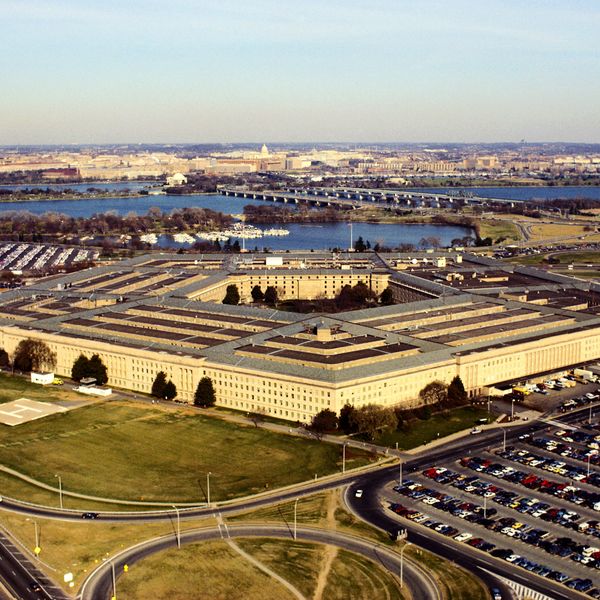
Nora, 24, from Washington, D.C., stands outside of the White House on January 8, 2020. (Photo: Samuel Corum/Getty Images)
Fueled by US Under Trump, Global Military Spending in 2019 Had Biggest Increase in a Decade
The amount the United States increased in defense spending between 2018 and 2019 was nearly the same as the United Kingdom's entire defense budget.
2019 saw the biggest increase in global military spending in a decade, according to data published Friday, which also showed the United States ramping up war expenditures under President Donald Trump.
The findings are from The Military Balance 2020, the latest annual assessment from the International Institute for Strategic Studies (IISS) formally launched at the Munich Security Conference.
According to the report, which measures over 170 countries, global defense spending rose 4% in 2019 compared to 2018 amid "an unstable international security environment."
\u201cGlobal defence spending has reached its highest level in a decade, IISS #MilitaryBalance data published today shows. Find out more in The Military Balance 2020 \u2013 OUT NOW | https://t.co/4sQPYYuTVV\u201d— IISS News (@IISS News) 1581689700
The U.S. continued to claim top spot in military expenditures, spending $638 billion in 2019. China was the second biggest spender at $185 billion. Both countries' spending grew 6.6% compared to the prior year.
But, "the trajectory of the two states' defense spending is diverging," wrote Lucie Beraud-Sudreau, IISS research fellow for Defence Economics and Procurement, in a related blog post. "The budget increase in the U.S. was the largest in 10 years, and spending has increased year-on-year since U.S. President Donald Trump took office. While spending is still rising in China, the pace of growth is decelerating." As a result, the spending gap between the two countries has widened.
The U.S. increase alone of $53.4 billion, the report added, was roughly on par with Britain's entire defense budget.
The increased U.S. spending came as the country "is simultaneously reducing its financial assistance to allies' defence budgets," Beraud-Sudreau added.
\u201c\u2018Nominal increase in US defence spending of US$53.4bn between 2018 and 2019 almost matched the UK\u2019s entire 2019 defence budget of US$54.8bn, and is equivalent to the 7th-largest defence budget in the world\u2019 | @chipmanj #MilitaryBalance #MSC2020 https://t.co/4DNxTV6Y2m\u201d— IISS News (@IISS News) 1581680108
Among the factors the report linked to the environment of uncertainty are the collapse of the Cold War-era Intermediate-Range Nuclear Forces (INF) Treaty, the unclear fate of the New START treaty, the Islamic State (ISIS), and the ongoing war in Yemen.
An Urgent Message From Our Co-Founder
Dear Common Dreams reader, The U.S. is on a fast track to authoritarianism like nothing I've ever seen. Meanwhile, corporate news outlets are utterly capitulating to Trump, twisting their coverage to avoid drawing his ire while lining up to stuff cash in his pockets. That's why I believe that Common Dreams is doing the best and most consequential reporting that we've ever done. Our small but mighty team is a progressive reporting powerhouse, covering the news every day that the corporate media never will. Our mission has always been simple: To inform. To inspire. And to ignite change for the common good. Now here's the key piece that I want all our readers to understand: None of this would be possible without your financial support. That's not just some fundraising cliche. It's the absolute and literal truth. We don't accept corporate advertising and never will. We don't have a paywall because we don't think people should be blocked from critical news based on their ability to pay. Everything we do is funded by the donations of readers like you. Will you donate now to help power the nonprofit, independent reporting of Common Dreams? Thank you for being a vital member of our community. Together, we can keep independent journalism alive when it’s needed most. - Craig Brown, Co-founder |
2019 saw the biggest increase in global military spending in a decade, according to data published Friday, which also showed the United States ramping up war expenditures under President Donald Trump.
The findings are from The Military Balance 2020, the latest annual assessment from the International Institute for Strategic Studies (IISS) formally launched at the Munich Security Conference.
According to the report, which measures over 170 countries, global defense spending rose 4% in 2019 compared to 2018 amid "an unstable international security environment."
\u201cGlobal defence spending has reached its highest level in a decade, IISS #MilitaryBalance data published today shows. Find out more in The Military Balance 2020 \u2013 OUT NOW | https://t.co/4sQPYYuTVV\u201d— IISS News (@IISS News) 1581689700
The U.S. continued to claim top spot in military expenditures, spending $638 billion in 2019. China was the second biggest spender at $185 billion. Both countries' spending grew 6.6% compared to the prior year.
But, "the trajectory of the two states' defense spending is diverging," wrote Lucie Beraud-Sudreau, IISS research fellow for Defence Economics and Procurement, in a related blog post. "The budget increase in the U.S. was the largest in 10 years, and spending has increased year-on-year since U.S. President Donald Trump took office. While spending is still rising in China, the pace of growth is decelerating." As a result, the spending gap between the two countries has widened.
The U.S. increase alone of $53.4 billion, the report added, was roughly on par with Britain's entire defense budget.
The increased U.S. spending came as the country "is simultaneously reducing its financial assistance to allies' defence budgets," Beraud-Sudreau added.
\u201c\u2018Nominal increase in US defence spending of US$53.4bn between 2018 and 2019 almost matched the UK\u2019s entire 2019 defence budget of US$54.8bn, and is equivalent to the 7th-largest defence budget in the world\u2019 | @chipmanj #MilitaryBalance #MSC2020 https://t.co/4DNxTV6Y2m\u201d— IISS News (@IISS News) 1581680108
Among the factors the report linked to the environment of uncertainty are the collapse of the Cold War-era Intermediate-Range Nuclear Forces (INF) Treaty, the unclear fate of the New START treaty, the Islamic State (ISIS), and the ongoing war in Yemen.
2019 saw the biggest increase in global military spending in a decade, according to data published Friday, which also showed the United States ramping up war expenditures under President Donald Trump.
The findings are from The Military Balance 2020, the latest annual assessment from the International Institute for Strategic Studies (IISS) formally launched at the Munich Security Conference.
According to the report, which measures over 170 countries, global defense spending rose 4% in 2019 compared to 2018 amid "an unstable international security environment."
\u201cGlobal defence spending has reached its highest level in a decade, IISS #MilitaryBalance data published today shows. Find out more in The Military Balance 2020 \u2013 OUT NOW | https://t.co/4sQPYYuTVV\u201d— IISS News (@IISS News) 1581689700
The U.S. continued to claim top spot in military expenditures, spending $638 billion in 2019. China was the second biggest spender at $185 billion. Both countries' spending grew 6.6% compared to the prior year.
But, "the trajectory of the two states' defense spending is diverging," wrote Lucie Beraud-Sudreau, IISS research fellow for Defence Economics and Procurement, in a related blog post. "The budget increase in the U.S. was the largest in 10 years, and spending has increased year-on-year since U.S. President Donald Trump took office. While spending is still rising in China, the pace of growth is decelerating." As a result, the spending gap between the two countries has widened.
The U.S. increase alone of $53.4 billion, the report added, was roughly on par with Britain's entire defense budget.
The increased U.S. spending came as the country "is simultaneously reducing its financial assistance to allies' defence budgets," Beraud-Sudreau added.
\u201c\u2018Nominal increase in US defence spending of US$53.4bn between 2018 and 2019 almost matched the UK\u2019s entire 2019 defence budget of US$54.8bn, and is equivalent to the 7th-largest defence budget in the world\u2019 | @chipmanj #MilitaryBalance #MSC2020 https://t.co/4DNxTV6Y2m\u201d— IISS News (@IISS News) 1581680108
Among the factors the report linked to the environment of uncertainty are the collapse of the Cold War-era Intermediate-Range Nuclear Forces (INF) Treaty, the unclear fate of the New START treaty, the Islamic State (ISIS), and the ongoing war in Yemen.

